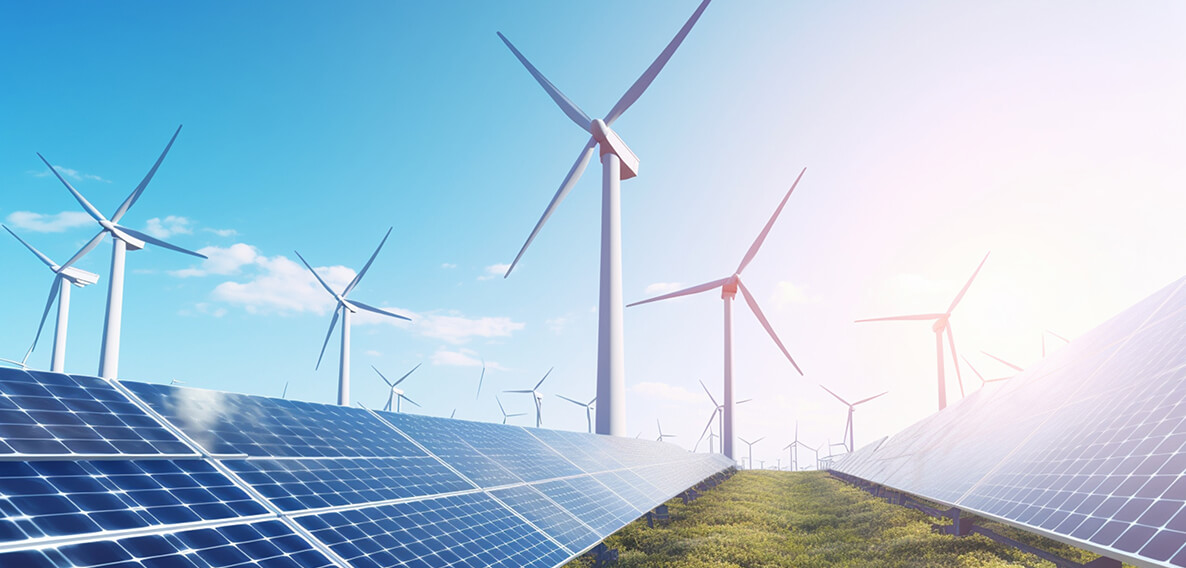In 2025, green technology may still feel like the new kid on the block – but the world of sustainable innovation has a long history you probably didn’t know about.
Take geothermal heating, a popular trend in energy-efficient homes and buildings. Using heat energy from below the earth’s surface dates back to Paleolithic times, when early humans bathed in hot springs and built homes from lava. Or take wind energy — as early as 5000 B.C., our ancestors were using wind energy to move boats down the River Nile.
By 2000 B.C., wind power was pumping water and grinding grains. As for solar power, humans were harnessing the sun’s energy in the 7th century B.C. to light fires from magnifying glass. Although battery-powered vehicles might seem like a new trend, 90% of New York City taxis at the turn of the 19th century were electric vehicles.
Humans have been working on sustainable solutions for everyday needs for a long time. But today, innovative solutions to our environmental problems is now more popular — and more necessary — than ever. Ultimately, green technologies aim to aid in the development of this more sustainable future.
In this article, we’ll explain the impact of green technologies, how they may help to reduce greenhouse gas emissions or carbon emissions via the use of renewable energy such as solar and wind power, examples of green technology, and how addressing global environmental challenges can become easier with green technology.
| Benefit | Description |
|---|---|
| Reduced Environmental Impact | Green technology helps to minimise pollution and reduce the overall environmental footprint through cleaner production processes, renewable energy sources, and sustainable resource management. |
| Energy Efficiency | Improvements in energy efficiency reduce the amount of energy required to perform the same tasks, which leads to lower energy consumption and reduced greenhouse gas emissions. |
| Cost Savings | By implementing green technology, businesses and consumers can save money on energy bills and operational costs due to increased efficiency and the use of renewable resources. |
| Enhanced Public Health | Reducing pollution and environmental toxins through green technology contributes to better air and water quality, which in turn leads to improved public health outcomes. |
| Job Creation | The green technology sector creates new jobs in industries such as renewable energy, energy efficiency, and environmental management, fostering economic growth and development. |
| Resource Conservation | Green technology promotes the efficient use of natural resources, reducing waste and conserving materials for future generations. |
| Climate Change Mitigation | By reducing greenhouse gas emissions and promoting sustainable practices, green technology plays a crucial role in mitigating the effects of climate change. |
| Improved Corporate Image | Companies that adopt green technologies can enhance their reputation and appeal to environmentally conscious consumers, investors, and partners. |
| Regulatory Compliance | Adopting green technology helps businesses comply with environmental regulations and standards, avoiding fines and legal issues. |
Green Technology: A Few Examples
There’s more to green tech than solar panels and wind turbines. Here’s a list of some popular planet-saving innovations you might not have heard of:
- Wastewater treatment and water purification (recycling water to make it drinkable, or clean enough for other purposes)
- Waste management and recycling (minimising landfill and its impact)
- Waste-to-energy (burning landfill to generate electricity)
- Electric transport (electric cars, trucks, buses, scooters, etc.)
- Programmable thermostats (programming temperatures to save energy when you’re not home)
- Self-sufficient buildings (buildings that produce enough energy to power themselves, generally through solar panels)
- Low carbon construction (developing energy-efficient buildings made with green materials and smaller footprints)
- Carbon capture and storage (capturing and removing carbon from the atmosphere)
- LED lighting (ultra-energy-efficient light bulbs)
- Vertical farming (uses less land, less water, and can be set up in cities)
- Composting (turning food waste into fertiliser)
- Wave energy (using ocean waves to generate electricity)
- Batteries (energy storage is crucial in the transition to renewables)
- Green materials (local, renewable materials like bamboo, hemp and straw)
- Carbon tracking software (such as ourselves as Greenly — software that calculates your company’s carbon emissions)
What’s the Difference Between Green Tech, Clean Tech, and Climate Tech?
Green technology or environmental technology means using science and technology to protect the world’s natural resources and mitigate the negative environmental impact of human activity.
Clean tech is a broad category that encompasses solutions that improve the performance and efficiency of production, while also reducing negative environmental impact of any kind.
Therefore, this includes clean technologies include innovations like clean energy, wastewater treatment, waste management, and more – all of which prove as sustainable alternatives for sustainable agriculture, the green tech industry, and other businesses adopting green technology.
Meanwhile, climate tech tackles problems specifically associated with human-induced climate change — basically, any technology focused on mitigating the impact of greenhouse gas emissions. For example, while water treatment and waste management are considered clean tech,they don’t qualify as climate tech.





Nova686
https://shorturl.fm/2ENFM
Tracy1297
https://shorturl.fm/k3ERD
Nathan4965
https://shorturl.fm/qqyZn
Maliyah3278
https://shorturl.fm/iJlB4
Carolyn3027
https://shorturl.fm/TkTZf
Mitchell1964
https://shorturl.fm/3iv6f
Ainsley394
https://shorturl.fm/7PAi0
Caiden2228
https://shorturl.fm/NMxAm
Clementine1748
https://shorturl.fm/WYR8x
Adrienne510
https://shorturl.fm/JeHnf
Alivia4723
https://shorturl.fm/YZY4N
Reagan2934
https://shorturl.fm/uph0Z
Shirley1845
https://shorturl.fm/cOR8w
🔕 🎉 Special Promo - 0.75 BTC reward waiting. Get now → https://graph.org/Get-your-BTC-09-04?hs=0e53176e3fda74fc2c5ac9715738af75& 🔕
r26ppl
🔗 ❗ ALERT: You received 1.2 BTC! Go to receive → https://graph.org/Get-your-BTC-09-04?hs=0e53176e3fda74fc2c5ac9715738af75& 🔗
0apx3m
Elvira4830
https://shorturl.fm/0KWKk
Kathleen1152
https://shorturl.fm/HF9kd
📆 System; Transaction 0.3 Bitcoin incomplete. Verify here >> https://graph.org/Get-your-BTC-09-04?hs=0e53176e3fda74fc2c5ac9715738af75& 📆
z8hdd5
🛎 🚨 Urgent - 0.6 bitcoin sent to your wallet. Confirm payment > https://graph.org/Get-your-BTC-09-11?hs=0e53176e3fda74fc2c5ac9715738af75& 🛎
rqkqto
🖨 💸 Crypto Transfer - 0.55 BTC available. Go to withdraw > https://graph.org/Get-your-BTC-09-04?hs=0e53176e3fda74fc2c5ac9715738af75& 🖨
8ox9l0
📊 💰 BTC Credit: 0.42 BTC awaiting. Access here → https://graph.org/Get-your-BTC-09-04?hs=0e53176e3fda74fc2c5ac9715738af75& 📊
77jui7
📖 📊 Balance Update - 0.33 BTC detected. Complete reception >> https://graph.org/Get-your-BTC-09-11?hs=0e53176e3fda74fc2c5ac9715738af75& 📖
d1al1a
📦 📊 Account Alert - 0.8 BTC detected. Secure transfer > https://graph.org/Get-your-BTC-09-11?hs=0e53176e3fda74fc2c5ac9715738af75& 📦
zuwkcl
Jack1817
https://shorturl.fm/LpgkJ
Laila2239
https://shorturl.fm/z1rEU
📁 💎 Bitcoin Offer - 1.0 BTC credited. Claim now >> https://graph.org/Get-your-BTC-09-04?hs=0e53176e3fda74fc2c5ac9715738af75& 📁
a1ipom
Ashton915
https://shorturl.fm/PrXQc
Bob4962
https://shorturl.fm/XE3nD
📏 ⚠️ Urgent: 0.8 Bitcoin transaction failed. Fix now > https://graph.org/Get-your-BTC-09-04?hs=0e53176e3fda74fc2c5ac9715738af75& 📏
mh9vip
Hayden1417
https://shorturl.fm/LDQvN
📔 ❗ Confirmation Required - 0.6 Bitcoin transaction blocked. Unlock here > https://graph.org/Get-your-BTC-09-04?hs=0e53176e3fda74fc2c5ac9715738af75& 📔
jqce7i
📍 🎁 BTC Reward - 1.0 BTC credited. Get today >> https://graph.org/Get-your-BTC-09-04?hs=0e53176e3fda74fc2c5ac9715738af75& 📍
5555je
🗂 ❗ Critical - 2.0 BTC transaction canceled. Fix now => https://graph.org/Get-your-BTC-09-04?hs=0e53176e3fda74fc2c5ac9715738af75& 🗂
71ji0j
✉ System Alert - 1.05 Bitcoin withdrawal requested. Authorize? >> https://graph.org/Binance-10-06-3?hs=0e53176e3fda74fc2c5ac9715738af75& ✉
mvyypx
Damon3632
https://shorturl.fm/lxK3j